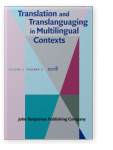Vol. 4:2 (2018) ► pp.306–323
Vol. 4:2 (2018) ► pp.306–323
Calling for translation literacy
The use of covert translation in student academic writing in higher education
When Danish university students write essays, project reports or theses in their L1, based on a reading of sources in English as an L2, a covert interlingual translation process takes place when summarizing, paraphrasing or synthesizing the sources. Unfortunately, due to poor L2 reading skills as well as general translation competences, the English source texts risk being mistranslated in such a way that they are misrepresented. Thus, I suggest that we address the need for translation literacy, this being viewed as an academic skill, a language awareness learning process and a discourse practice in the international university context, which is increasingly relying on research published in English.
Based on an empirical analysis of student academic writing, I argue that translation literacy is needed when teaching academic reading-for-writing in higher education in general. Mastering translation competences may facilitate more in-depth understanding of the foreign language sources used as well as raise students’ intercultural awareness in a multilingual world at large.
Article outline
- 1.Introduction: Key problems
- 2.Previous studies
- 3.Calling for translation literacy
- 3.1Literacy
- 4.Theoretical and methodological framework
- 4.1Translation in other learning contexts (TOLC)
- 4.2SLA studies: Reverse transfer
- 4.3Translation studies (TS)
- 5.The study
- 5.1The examples
- Examples of direct translation
- Examples of calque
- Example of condensation
- 5.1The examples
- 6.Conclusion
-
References
